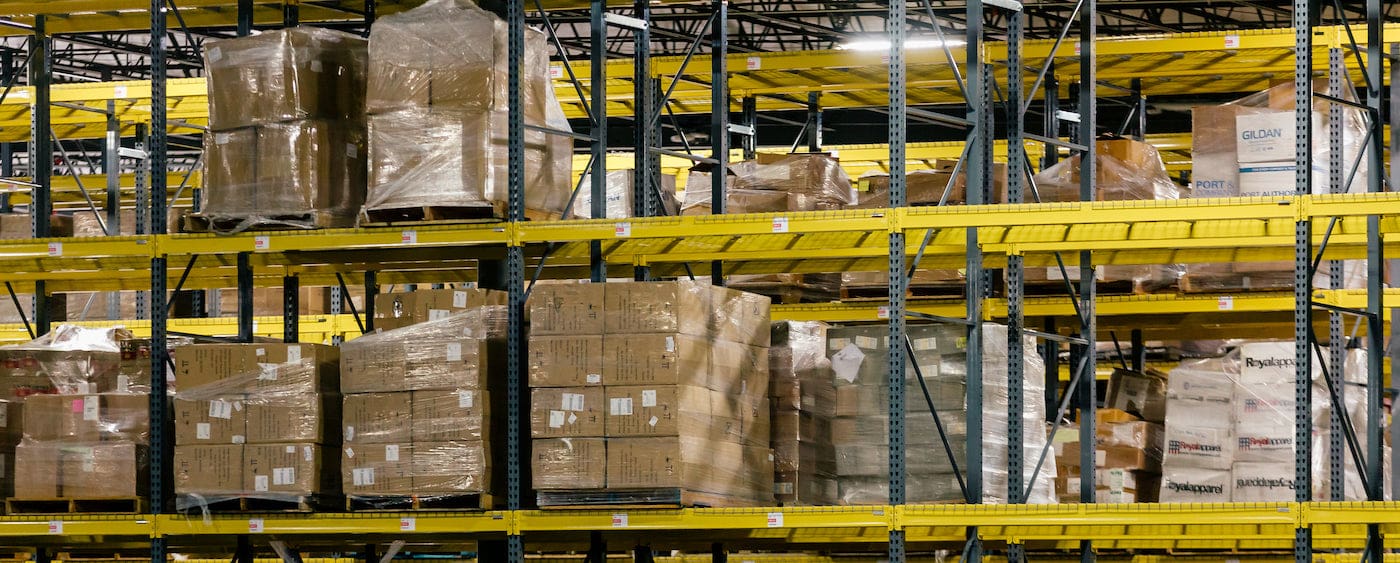Table of Contents
** Minutes
What makes warehouse efficiency so important in 2023?
How to measure warehouse efficiency
What an inefficient warehouse can do to your business
8 steps to improve warehouse efficiency
Warehousing is more than just a place to store inventory.
In a lot of ways, it becomes the central hub for your business. It’s where inventory is received, organised, stored, and prepped to ensure fast fulfilment and shipping.
There’s no doubt that ecommerce warehousing operations plays a crucial role in supply chain efficiency.
But what exactly makes a warehouse efficient? And what are the steps a business can take to improve and measure efficiency?
In this article, we share how you can improve warehouse efficiency in 8 simple steps.
What makes warehouse efficiency so important in 2023?
Proper warehouse management trickles down into other aspects of your supply chain such as fulfilment and shipping, ensuring better overall efficiency.
The ecommerce supply chain is extremely prone to unexpected setbacks. Take, for instance, the COVID-19 pandemic that caused a massive supply chain disruption globally.
With national lockdowns that effectively slowed down or blocked the transportation of finished goods and raw materials alike, many ecommerce businesses faced serious issues in keeping their supply chain operations.
The pandemic highlighted pre-existing issues in the supply chain as many ecommerce businesses were unprepared for certain supply chain bottlenecks.
72% of respondents in an Ernst & Young survey said that the pandemic had a negative impact on their company. Only 2% of respondents were fully prepared for the pandemic.
Similarly, there was a labour shortage that affected global supply chains even as the pandemic eased down. Many warehouse roles to hire were being left open.
By late 2021, jammed ports were a common occurrence as there were no workers to unload goods. Ports in Los Angeles and Long Beach saw more than 70 container ships being stuck because of a shortage of workers.
The challenge becomes even harder when your warehouse isn’t running as efficiently as it should, which is where your warehouse efficiency plays a vital role.
How to measure warehouse efficiency
So, how do you know if your warehouse is running efficiently?
By conducting regular audits and tracking KPIs, you can get a sense of what’s working and what’s not, before making an investment in warehouse technology or hiring for new roles.
Audits
A warehouse audit involves observing different warehousing processes to ensure that they’re running efficiently.
An audit can answers questions, such as:
- Are there any areas of the warehouse where the process slows down?
- Is there an equipment issue that’s slowing down certain tasks or causing a safety risk?
- Is there a way to reorganize the space for efficient warehouse picking?
With the data collected warehouse managers will be able to suggest improvements to increase productivity and efficiency.
KPIs
Before you begin making improvements, you’ll want to define what warehouse KPIs you’ll track.
For example, tracking warehouse receiving times can tell you a lot about how productive your workers are when receiving new inventory. You can also tracking for inventory accuracy at this stage.
Similarly, picking efficiency, cycle time, total order cycle time, and time lost due to mistakes are other KPIs that can help you measure your warehouse efficiency.
You can break down different categories of warehouse KPIs to measure which areas need the most improvement. The different areas include:
- Inventory: how well you’re managing inventory levels
- Receiving: speed and accuracy of this process
- Put-away: putting items away in the right places within a certain time frame
- Picking and packing: speed and accuracy of fulfilling orders
- Performance: overall time management across your warehouse
- Safety: number of days without work-related injuries
What an inefficient warehouse can do to your business
Efficient warehousing can ensure you maintain supply chain agility.
But the importance of warehouse efficiency can be seen by taking a closer look at how inefficient warehouse management can impact your business.
Let’s take a look at some of the main issues that can arise due to an inefficient warehouse.
Slow lead and delivery times
One of the most obvious effects of an inefficient warehouse is that it takes much longer for different processes to be completed.
For example, if workers are unable to put away items efficiently after receiving it, it means that you may experience staffing shortages in other areas of the warehouse.
Or, if workers can’t easily locate the items they need to pick, it will significantly delay the fulfilment process.
This means that your overall fulfilment lead time slows down, which makes it harder to maintain customer satisfaction. Since orders can’t be shipped out on time, there’s also a delay in your last-mile delivery times.
Frustrated customers
When there are inefficiencies in your supply chain operations, orders are consistently taking longer to get shipped out. Customers regularly have to follow up and wait a long time to get their orders.
Now imagine how this would affect the customer experience. You can bet that you’re going to deal with frustrated customers on a regular basis.
High volume of returns
Order inaccuracies and item damages are some of the major risks associated with warehousing inefficiencies. That means your customers will often get incorrect items or damaged products, resulting in a higher volume of returns.
In some cases, customers might simply choose to return their orders because they waited too long and became frustrated. They might have even gone so far as to order a similar product from your competition.
Regardless of the specifics, inefficiencies in your warehouse will subsequently lead to more customers returns.
Loss of growth and revenue
All the issues mentioned above can add up to cost your business in terms of revenue and growth opportunities.
Slow lead times mean you’re unable to fulfil increasing order volumes and inefficient warehousing processes means the operational costs will add up.
Not to mention the need to pay workers overtime because some of the tasks couldn’t be completed on time. Higher costs will subsequently lead to lower profit margins and revenue.
8 steps to improve warehouse efficiency
Once you conduct an audit and define KPIs to track, it’s time to make improvements.
Here are 8 steps to help you get started.
1. Employee cross-training
While you may be looking to have a team of employees who are highly specialized in their respective areas of expertise, this can actually result in inefficiencies.
If one worker needs time off or decides to quit, you’ll instantly become short-staffed, which will lead to inefficiencies in that department.
Instead, opt to cross-train your employees, so they’re capable of performing different tasks within your warehouse. This will allow you more flexibility in your workforce allocation, which means that your workers will be able to mitigate staffing shortages across various departments.
2. Define and act on KPIs
Numbers and data can tell you a lot about how your warehouse is performing, which will then inform your improvement strategies.
That’s why it’s crucial to define the KPIs that are more specific to efficiency-related processes, so you know where you’re lagging behind. Start by narrowing down the KPIs that will tell you how efficiently your warehousing tasks are being carried out.
Then once you get the data on these KPIs, you can come up with actionable strategies to improve on them.
For example, if you notice that your put-away cycle time is too long, you can check what’s holding things up in this process and then develop measures to improve efficiency.
3. Improve your inventory tracking
Inventory visibility plays an important role in how different warehousing tasks are carried out. When you know exactly how much inventory you have and where each item is located, you can better plan your processes for greater efficiency.
Real-time inventory tracking is essential to understand how many items are available so you don’t accidentally end up with backorders.
If inventory runs low, you can set up reorder points so you can order more inventory in a timely manner.
4. WMS implementation
By implementing an inventory tracking system with a warehouse management system (WMS), you can easily track inventory in real time.
This system helps to ensure that every aspect of your warehousing operations is properly coordinated with optimised for greater efficiency. It provides suggestions for optimised routes and methods to allow for efficient picking and warehouse put-away.
A WMS coordinates with RFID or barcode inventory scanners, which your employees can use during their put-away and picking activities to update your inventory data.
“When trying to leave the fulfilment network to return back to ShipBob, the fulfilment network had 1,500 units of missing inventory that they couldn’t find.
Because of a lack of ownership of the entire fulfilment stack, it’s been difficult to rectify, unlike with ShipBob who owns the entire stack: inventory and order management system, warehouse management system, and their fulfilment centres.”
Gerard Ecker, Founder & CEO of Ocean & Co.
5. Optimise your warehouse layout for space and travel time
How your warehouse is set up is one of the main factors that affect the efficiency of tasks being carried out. If workers can’t move easily in aisles or have a hard time locating items, you can expect slower operations.
Your warehouse setup must be optimised in a way that will enable your team to seamlessly move within the warehouse and locate the items they need to pick.
For example, warehouse slotting is a common practice that involves organising the warehouse space by SKU number, product type, or any other type of product characteristic.
Another option is to optimise your warehouse layout so that different machines and picking equipment can move around without any issues.
Additionally, use shelving systems that allow for easy SKU management and neat product organisation.
“We’re going to be expanding our warehouse space from 10,000 sq. ft. to 16,000 sq. ft., and for getting started in the new space we won’t even need ShipBob to come out and assist us with that move.
They taught us how to do everything: get the locations up, map the warehouse, everything. We’ll be able to onboard ourselves which is cool to see.”
Jourdan Davis, Operations Manager at Pit Viper
6. Have a custom replenishment strategy
Having an inventory replenishment strategy in place helps to optimise inventory, especially if you use technology to automate the process.
There are many different ways to manage inventory replenishment. Some of the best practices include setting up reorder points, implementing a top-off method, or relying on inventory automation technology.
Having a strategy in place helps prevent stockouts, as well as overstocking which can cause an accumulation in dead stock.
“We are very impressed by ShipBob’s transparency, simplicity, and intuitive dashboard. So many 3PLs have either bad or no front-facing software, making it impossible to keep track of what’s leaving or entering the warehouse.
On the supply chain side, I just throw in what we placed at the factory into a WRO in the ShipBob dashboard, and I can see how many units we have on-hand, what’s incoming, what’s at docks, and so on. I can see all of those numbers in a few seconds, and it makes life so much easier.”
Harley Abrams, Operations Manager of SuperSpeed Golf, LLC
7. Safety first
It’s important to prioritise warehouse safety so that you can prevent accidents and injuries that would lead to unexpected process disruptions and staffing shortages.
In addition to training your workers on safety, managing timely repairs and replacements on equipment can also reduce the risk of warehousing accidents.
Moreover, equip your warehouse with the necessary signage, labels, shelves, and safety tools that will ensure the safety of your employees.
8. Invest in fulfilment performance
Fulfilment is one area of your warehousing operations that could seriously impact your overall efficiency.
It’s important to make necessary investments in this area to improve your performance and speed up the process.
This would typically involve implementing the right tools and technology to improve things like order accuracy and picking efficiency.
If you don’t have the bandwidth to improve fulfilment performance, it’s not uncommon to partner with a third-party logistics provider that has the infrastructure to deliver fast and reliable fulfilment.
“In an average week, we’re shipping out around 30,000 orders. When we first started with ShipBob, it was about 65% of that. The US is our biggest market, and we’ve been able to continue to deliver strong growth as a result of the strength of our internal team and our relationship with trusted partners like ShipBob.
Scaling quickly comes with its challenges, but ShipBob was able to take some of the complexities of that growth off our hands. We needed a fulfilment partner that could keep up and get orders shipped out fast without additional work by us or our needing to hire additional staff. ShipBob filled that void.” –
Stephanie Lee, COO at PetLab
ShipBob is an ecommerce business’ warehousing partner
Partnering with omnichannel fulfilment like ShipBob is your business’ ticket to enhanced warehouse efficiency. ShipBob has maintained a strong track record across all fulfilment centres, with short average receiving times, fast fulfilment, and high accuracy rates.
ShipBob operates fulfilment centres across the world, enabling brands to reach customers faster and more affordably no matter where they live.
You can choose to store inventory in one or more fulfilment centre locations, or implement our technology into your existing warehouse operations.
“ShipBob’s system for picking orders has cut down on labour costs, reduced lost inventory, and eliminated the need for double shipping. That’s been huge for us. Our order picking and routing has also greatly improved with ShipBob.
With ShipBob’s WMS, we can create the most efficient routes through the warehouse, which has cut down on an insane amount of time and made picking, packing, and shipping so much more efficient.
Running a warehouse is unpredictable. But ShipBob has definitely helped with that. Thanks to ShipBob WMS, we have access to more data. Now we know how many orders an employee can complete in an hour so we can forecast for labour a lot better than we did before.”
Jourdan Davis, Operations Manager at Pit Viper
Plus, ShipBob’s WMS is the best solution if your business wants to keep fulfilment in-house but need an affordable and reliable way to manage warehouse operations and inventory.
ShipBob’s fulfilment platform gives you real-time inventory visibility and enables you to maximise pick and pack efficiency. It also lets you keep track of your warehouse productivity and manage various aspects of your warehousing processes to enhance coordination and overall efficiency.
Warehouse efficiency FAQs
Below are answers to the common questions about warehouse efficiency.
How is warehouse efficiency measured?
Warehouse efficiency can be measured by performing a warehouse audit and by keeping track of relevant KPIs such as picking accuracy, receiving timelines, picking cycle time, and put-away cycle time.
How do you manage warehouse efficiency?
You can manage warehouse efficiency by conducting audits, monitoring KPIs, and implementing warehouse management technology that will improve visibility and process coordination. Employee cross-training and warehouse layout optimisation are also beneficial ways to improve efficiency.
What are the factors affecting warehouse efficiency?
Factors like your warehouse receiving and put-away timelines and accuracy rates, picking speeds, and fulfilment processes can affect your overall warehouse efficiency.



